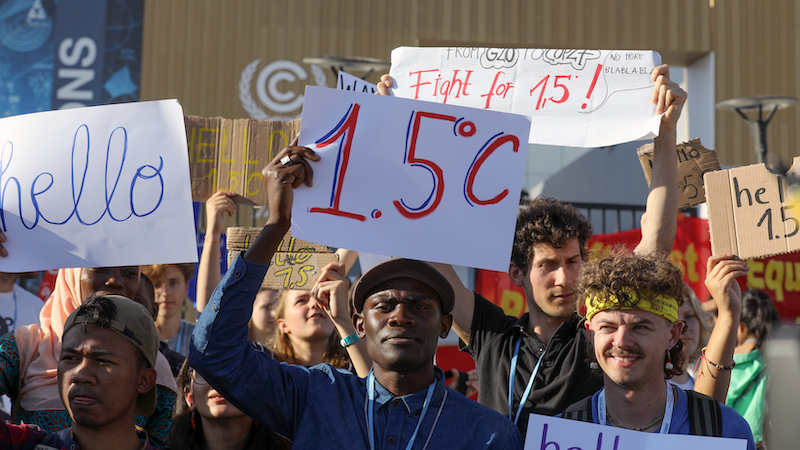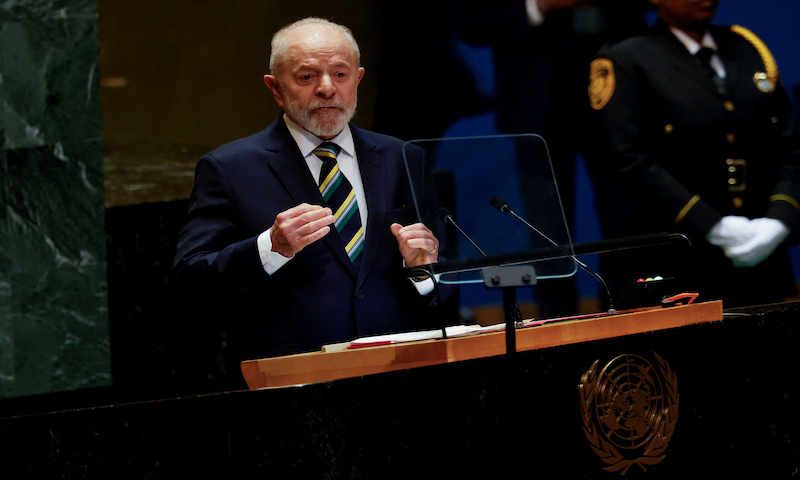UAE, Azerbaijan and Brazil have promised NDCs compatible with the safest warming limit in the Paris Agreement – but it’s not clear what they mean
The three countries hosting the annual COP climate summits from 2023-2025 – known as “the Troika” – have again called on governments to submit stronger climate action plans that can keep the warming goals of the Paris Agreement “within reach”.
The United Arab Emirates, Azerbaijan and Brazil this week in New York reiterated their promise to lead by example and produce by the end of this year nationally determined contributions (NDCs) aligned with the Paris pact’s objective of limiting global warming to 1.5C above pre-industrial levels.
But they failed to announce any numbers or flesh out what a 1.5C-compatible NDC means for them. Observers keen to understand how the three nations will reconcile a science-based climate plan with their expanding fossil fuel ambitions were left disappointed.
“We witnessed a worrying case of cognitive dissonance,” said Romain Ioualalen, global policy manager with Oil Change International, which campaigns against fossil fuels. “At a time of grave climate urgency, the COP Troika is failing to deliver the leadership and clarity needed to raise climate ambition.”
The Troika has previously indicated that there is no universally accepted definition of what a 1.5°C-aligned climate plan should or should not include. “It’s up to each one to decide,” Brazil’s head of delegation, Liliam Chagas, said at the Bonn climate talks in June, raising fears of “1.5-washing”.
‘Ten tests’ for a 1.5C climate plan
That view is not shared by many climate experts and campaigners who are issuing suggestions for what such an NDC should look like.
A group of leading civil society organisations this week published an open letter that outlines “ten essential tests” to determine whether countries’ plans meet the 1.5C goal – seen as safer than the other, higher ceiling of “well below 2 degrees” set in the Paris Agreement.
The tests outlined in the letter include a commitment to end fossil fuel expansion, detailed and measurable targets both for the whole economy and for specific sectors such as transport, building and agriculture, provisions for wealthier countries to scale up climate finance, and measures to protect natural ecosystems and make food systems greener.
UN climate chief warns of “two-speed” global energy transition
“A lot of the failure or success of [the] Paris [Agreement] is going to be determined in the next eight or nine months as countries put forward their next round of NDCs,” said Alden Meyer, a senior associate at E3G and veteran watcher of the UN climate process. “If these don’t step up and meet the mark, it’s really our last chance… this is a critical moment.”
To limit average temperature rise below 1.5C, scientists with the Intergovernmental Panel on Climate Change say global emissions need to peak before 2025, shrink 60% by 2035 from their 2019 level, and continue on a steep downward trajectory, reaching net-zero emissions of carbon dioxide by around mid-century.
Fossil fuels in the spotlight
The next round of updated NDCs, due by next February, should turn the goals agreed at COP28 last year into practice, advocates say. In the energy sector, that means laying out plans to triple renewable energy capacity and double the rate of improvement in energy efficiency by 2030 – and, crucially, transition away from fossil fuels.
Climate experts and campaigners have stressed that a 1.5C-aligned NDC needs to include an explicit commitment to no new coal, oil and gas exploration, as well as credible targets for slashing existing production and eliminating fossil fuel subsidies.
“Claiming to lead on climate while continuing the expansion of oil, gas and coal production is indefensible at this point,” said Natalie Jones, policy advisor at the International Institute for Sustainable Development. “Governments need a plan for reducing reliance on fossil fuel production,” she added.
Senegalese banker Ibrahima Cheikh Diong picked to lead new loss and damage fund
Fossil-fuel reduction targets will be closely watched as a litmus test for the ambition of major hydrocarbon producers, including the Troika of COP presidencies. The UAE, Azerbaijan and Brazil are set to increase their combined oil and gas production by 33% by 2035, according to a new analysis by Oil Change International.
Brazilian President Luiz Inácio Lula da Silva aims to turn his country into the world’s fourth largest petrostate (it now ranks ninth), opening new extraction frontiers both on land and offshore, including in the Amazon. This plan contrasts with Brazil’s promise to present a new NDC aligned with the 1.5C temperature goal this year – reaffirmed by Lula himself in his speech at the UN General Assembly this week.
Brazil’s President Luiz Inacio Lula da Silva addresses the 79th United Nations General Assembly at U.N. headquarters in New York, U.S., September 24, 2024. REUTERS/Shannon Stapleton
“As long as the Brazilian government insists on extracting oil and gas, especially in the Amazon, talking about decarbonising the economy and a fair energy transition is a pure exercise in rhetoric,” said Ilan Zugman, Latin America managing director for campaign group 350.org.
Azerbaijan has similarly come under renewed criticism this week with researchers at Climate Action Tracker (CAT) slamming its existing climate goals as “critically insufficient”.
The scientif
Read More



This Post Has One Comment
I just could not depart your web site prior to suggesting that I really loved the usual info an individual supply in your visitors Is gonna be back regularly to check up on new posts
Comments are closed.